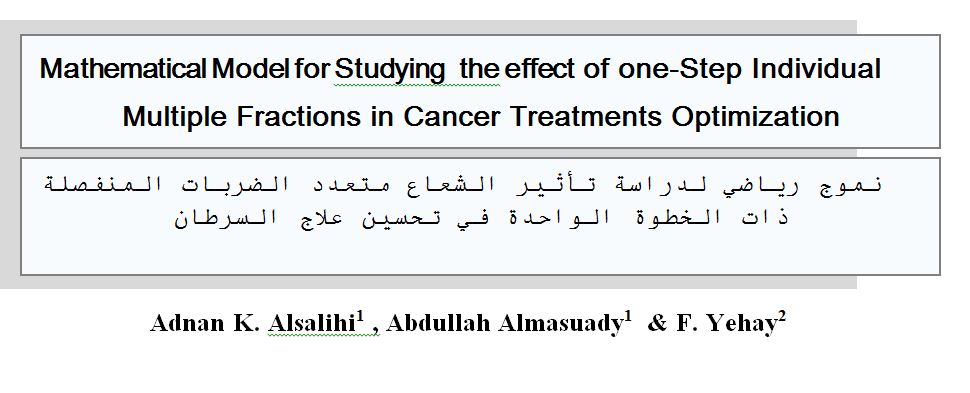Mathematical Model for Studying the effect of one-Step Individual Multiple Fractions in Cancer Treatments Optimization Adnan K. Alsalihi1 , Abdullah Almasuady1 & F. Yehay2
Main Article Content
Abstract
As connection with our previous publication, we have reported the application of a mathematical model for one–step with multiple fractions in cancer treatment optimization [1, 2]. In addition to the correction and extending for some previously calculated, we studied the important role of the initial tumor cell density on optimization results. We found similar behavior with different values but not equivalent. In this paper we present more physically reasonable new cases of (1-step) radiation profiles during the two fractions, three fractions, … , i fractions. By examining cases and expansion on the results by using the partial differential equation models which solved by using computational methods (MATLAB, we have obtained a great results. Finally we have compared different cases of one-Step i.e. with individual multiple fractions in mathematical models of cancer treatments optimization .
Keywords: Mathematical, Models, Glioblastomas , Radiation, Equation, Optimization
Article Details
References
References
- Meaney, C. (2019). Mathematical Modelling of Cancer Treatments Involving Radiation Therapy and Hypoxia-Activated Prodrugs (Master's thesis, University of Waterloo).
- Almasuady, A. Al-salihi Adnan and F. Yehay (2020). The Capability of Mathematical Models in Glioblastomas Cancer Treatments Optimization. Albaydha University Journal, 2(3), 156-164.
- Sanai, N., Alvarez-Buylla, A., and Berger, M. S. (2005). Neural stem cells and the origin of gliomas. New England Journal of Medicine , 353(8), 811-822.
- Alvord, E. C., Jr. Shaw and C. M. (1991). The Pathology of the Aging Human Nervous System.(Philadelphia, PA: Lea and Febiger) pp 210–281.
- Hall, E. J., and Giaccia, A. J. (2006). Radiobiology for the Radiologist , International Journal of Radiation Oncology –Biology-Physics. (Vol. 6).
- Chicoine, M. R., and Silbergeld, D. L. (1995). Assessment of brain tumor cell motility in vivo and in vitro. Journal of neurosurgery, 82(4), 615-622.
- Nelson, S. J., and Cha, S. (2003). Imaging glioblastoma multiforme. The Cancer Journal, 9(2), 134-145.
- Hanahan, D., and Weinberg, R. A. (2000). The hallmarks of cancer. cell, 100(1), 57-70.
- Fisher, J. J. (1969). Theoretical considerations in the optimization of dose distribution in radiation therapy. The British journal of radiology, 42(504), 925-930.
- Brahme, A. (1984). Dosimetric precision requirements in radiation therapy. Acta Radiologica: Oncology, 23(5), 379-391.
- Brahme, A., and Argren, A. K. (1987). Optimal dose distribution for eradication of heterogeneous tumors. Acta Oncologica, 26(5), 377-385.
- Ribba, B., Kaloshi, G., Peyre, M., Ricard, D., Calvez, V., Tod, M., ... and Ducray, F. (2012). A tumor growth inhibition model for low-grade glioma treated with chemotherapy or radiotherapy. Clinical Cancer Research, 18(18), 5071-5080.
- Harpold, H. L., Alvord Jr, E. C., and Swanson, K. R. (2007). The evolution of mathematical modeling of glioma proliferation and invasion. Journal of Neuropathology and Experimental Neurology, 66(1), 1-9.
- Swanson, K. R. (1999). Mathematical modeling of the growth and control of tumors. PhD Thesis. University of Washington.
- Woodward, D. I. W., Cook, J., Tracqui, P., Cruywagen, G. C., Murray, J. D., and Alvord Jr, E. C. (1996). A mathematical model of glioma growth: the effect of extent of surgical resection. Cell proliferation, 29(6), 269-288.
- Tracqui, P., Cruywagen, G. C., Woodward, D. E., Bartoo, G. T., Murray, J. D., and Alvord Jr, E. C. (1995). A mathematical model of glioma growth: the effect of chemotherapy on spatio-temporal growth. Cell proliferation, 28(1), 17-31.
